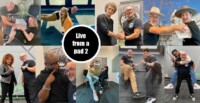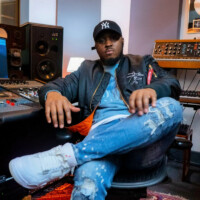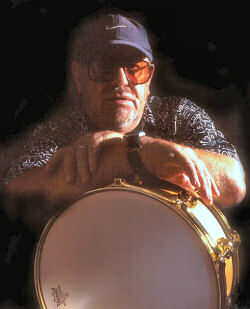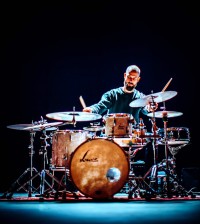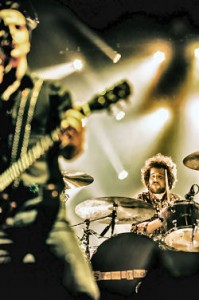 Besides the huge success as an original member of the Noisettes, Jamie Morrison has played the likes of Duffy, Brian Adams, Emelie Sande, Sia and many more of the biggest artists in the industry. On top of that workaholic Jamie runs his own label, works as a producer and writer and designs his own poncho collection.
Besides the huge success as an original member of the Noisettes, Jamie Morrison has played the likes of Duffy, Brian Adams, Emelie Sande, Sia and many more of the biggest artists in the industry. On top of that workaholic Jamie runs his own label, works as a producer and writer and designs his own poncho collection.
Since 2012 Morrison keeps the groove in one of the UK’s biggest rock bands, the Stereophonics. And all of this before his 32nd birthday…
I met Jamie at his house in London to have a chat about his experiences in bands and session work, his doings as a writer and producer and the importance of a clear mindset.
You were an original member of the Noisettes. How did that come about?
I did an audition for this girl in town, drove in in my little car, just passed my test, and was asked to play for this girl called Willis. A week later I was on Jools Holland – REM in front of me, Yoko Ono to the left, B.B.King to the right.
The guy who was doing sound for REM was a producer named Charlie Francis and he was about to produce two kids but he didn’t quite like the drummer. A few days later I got a call from him asking me to come down to the studio for a jam. That’s where I met Shingai and Dan, we became the Noisettes and that was my next eight years. I signed that first deal when I was 18.
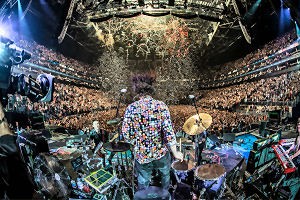 So you started your career in a band? Was that always the goal?
So you started your career in a band? Was that always the goal?
I started off as a drum geek, like all of us. And like all of us I went into the session world. You have these skills and you wanna play with as many people as possible. You wanna play latin, jazz, rock, reggae…. because you can. Then I met the band and it took me into that world. I always thought I’ll be a great session drummer, I never in my life thought I would be in a band!
The Noisettes was a very interesting experience. Formed after a week, seven days after we recorded one song we were on the way to L.A. to sign a record deal because they had seen a picture of us, not heard a single song. We got signed of a picture! In L.A. we each got a car, we got a penthouse – it was ridiculous. That was the tail end of excess in record deals. There was a time when we looked a bit tired so the label boss sent us on holiday. She hired us Al Capone’s house in the Mojave desert, drives us out there in a Limo, we walk around in bathrobes, turtles walking around everywhere – it was incredible! So unrelated to music. I’m very grateful to have experienced that but when you come out of it you just realise that’s not how it is AT ALL.
Everything happened so quickly with that band and we were just wildly different characters with wildly different agendas but when we got put on stage, something really cool happened. Once we reached the roof there was no point in us being together.
You did quite a bit of session work after that. How did that come about?
Yes, when I came out of the Noisettes I went straight back into being a session drummer. I played with Brian Adams, Martha Reeves, John Lord, KT Tunstall, Duffy, Birdy, Sia – I’ve been very, very blessed! That all happened after the Noisettes.
To be honest, the Noisettes ended pretty badly but literally the day after, I got a call from producer Jim Abbiss who had made the last Noisettes album with us. Jim was just working on the new KT Tunstall record and asked me to go to Berlin for a month to record drums at the famous Hansa studios. So I was in bits but I couldn’t show that. I sucked it in and did the session.
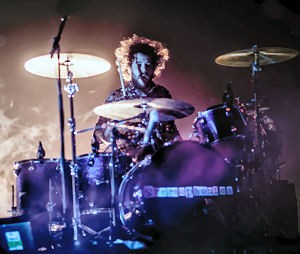 When I got back I got the call for Duffy – that was my next eight months. I just knew I needed to work.
When I got back I got the call for Duffy – that was my next eight months. I just knew I needed to work.
I did a good three years of sessions and working with people who – I won’t name names – as an artist weren’t quite sure of who they are. Fundamentally their art wasn’t ‘to perform’ and that made me think: why am I here?!
I was in a band, I understand the process of making art. I also understand the process of serving a purpose as a session drummer in a unit. But when the artist you’re working for doesn’t believe in their art, how am I meant to believe in this small element of what I’m supposed to do? If you can’t sing your song, how am I supposed to play the beat behind that? I mean, am I looking too deep into it? Probably. But this is what I was feeling and I thought there’s something more to this.
I then stopped lots of the session work and only played for people that I really wanted to play with; like Brian Adams and Echo & the Bunnymen – I really wanted to do those! They both wrote some of my most favourite songs ever, so that really was a blessing.
Was that when you started writing?
Yes, you’ve seen my room in the house. It’s not a typical studio: there’s no big mixing desk but there are instruments everywhere. Well that my friend is how you make songs – when you haven’t got the pressure of a big studio and you’ve got a creative and cool environment. Just chilling, Sir.
Stereophonics are very active but if we have a day off, I’ll invite an artist round and we’ll write a song. And you know, when I go back to the Stereophonics the next day, I’m a better musician. I could have gone and spend the day practising drums for 10 hours and that would have made me a better drummer – but I think we want a better musician, because we want to write better songs and want to be a better band. We don’t want to be a great band with an awesome drummer, we want to be an awesome band! That’s the importance!
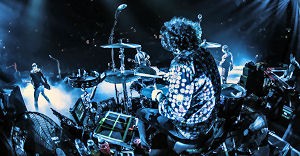 How did it generally translate to you coming from a band background back into the session work?
How did it generally translate to you coming from a band background back into the session work?
It was a little bit difficult but I have always been working in my downtime during the Noisettes and even before, so I wasn’t a surprise name on the circuit and people knew that I was out and about.
I did a lot of session recordings but Duffy was the first session band where I had to interact with human beings out of the context of a studio. I was lucky because the other band members were some of my best and oldest friends and they knew exactly what was going on, so I felt like they had my back.
My next gig after that was Martha Reeves and the Vandellas and that was through Duffy’s MD. He called me up and said: “Jamie, I’ve got this gig. She’s got a few festivals, you’ll fill in for…. – so you know how to read though, right?!” ……I went: “Yes, of course!” Put the phone down, straight to the music shop, bought all the books and spent a week teaching myself how to read (to a degree). I mean, you pick it up as a boy but unless you’re going into that world… I never used charts when I recorded.
So she’s headlining this festival in Kent. I got there, got given these charts, first song alone: four pages. But I got through it actually and I really enjoyed it.
So I was half way through 2010 now, definitely not in band, I was definitely a session musician again and it started to feel good. When you’re in a band, the more your playing will start sounding like the band – unless you’re actively pursuing other styles. Ultimately it’s like getting back on a bike but the more you do something, the better you are. The more you play different styles of music, the better you fit in.
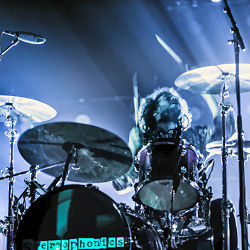 So how did the Stereophonics gig come about? Why did you decide against the session musician life?
So how did the Stereophonics gig come about? Why did you decide against the session musician life?
Well, that’s very easy. This was about three years after the Noisettes had finished. I still had the feeling that being a session musicians maybe wasn’t the right thing for me – unless you’re only playing with the people you really wanna play with, but you can’t decide that.
When I was in the Noisettes I was fortunate enough to play a show with the Stereophonics – Royal Albert Hall, 2009, Teenage Cancer Trust. I got to meet them there.
Fast forward, at the end of 2012 I saw that the drummer had left the Stereophonics. So I text a friend of mine who I know is close and said: If you need beats or anything, I’m here! Two minutes later I get a text from Kelly: ‘Hey man, come down and have a jam!’. Turns out when he knew the drummer would leave the band he said: “Oh I wish the Noisettes guy was available”. He thought I was still playing with them.
So he sent me a text telling me what songs to learn – and I was like: Mate, I know all these songs! He goes: “Good answer” and gave me a few more [laughs]. Actually, my very first band was a Stereophonics cover band, so I knew their first three albums in my blood.
So I went down to John Henry’s to audition, I think there was a whole line of people to do it, and what struck me the most about going in there was the camaraderie. The way they talk to each other and treat each other… you know, when you go into something for the first time, whatever you see there, that’s what they want you to see – and that was coming across right of the back. I’ve been in there for a long time now and it’s a real band, in every sense of the word!
I knew in my heart that’s what I needed as a drummer, as a musician, as an artist – I needed to feel that connection with people. You never get that in a session band. There are always these ulterior motives, there’s always some madness going on. Joining the Stereophonics I realised I’d actually never been in a band.
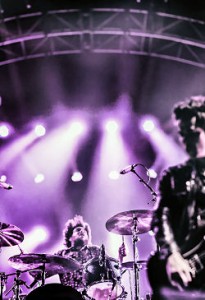 The Stereophonics have been going since 1992 and you’re the fourth drummer in the line-up. How did that feel for you? I mean, these are some big footsteps to cover.
The Stereophonics have been going since 1992 and you’re the fourth drummer in the line-up. How did that feel for you? I mean, these are some big footsteps to cover.
Being such a fan of the band and of the original drummer Stuart I was coming at it actually more from a respectful place, trying to respect these people who’d come before me. I’ve got so much respect for the songs, I listened to the records a lot and wanted to get back to the spirit. So once I got my head into that, it was ego-less, it wasn’t about me and my ability. In me somewhere I knew I had the ability and the confidence, I didn’t even worry about it.
Did you take their playing on board or did you try and make it your own a bit?
No, definitely not the latter! That’s not what was required. I mean, after a certain amount of time songs sort of naturally change live anyway and if anything, I wanted to bring it back to the spirit of the initial vibe.
I also changed my drum set completely for it – actually recreated Stuart Cables’ drum set. I even changed my drum sticks. I just thought I’ll have exactly the same instruments that they’ve used, even though that’s not what I’d use. I never had two floor toms, I didn’t use two crashes. My favourite set up always was hihat, snare and bass drum. So if anything I was trying to get to the essence of what I thought these three drummers were doing, and what I thought the songs were doing, I’m a song person ultimately.
If I listen to ‘Dakota’ or ‘Just Looking’ and I hear how the relationship between the beat, the vocals and everything else is just perfect. It doesn’t matter if you’re Dave Weckl or whoever – there is no one better playing these songs than these guys right there, so why should I change that?
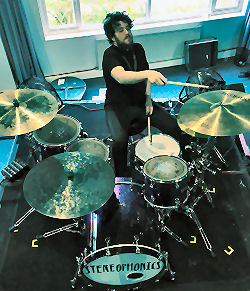 You guys have a new album coming out?
You guys have a new album coming out?
Yes, we got a beautiful new album coming out. We spent the whole of last year recording it. For day to day stuff we have our own studio here in London but for the tracking of the album we went to ICP in Belgium, which is a brilliant place. It was my third time recording there and I love it. It’s the only place in Europe that’s similar to an American style studio. No studios in England seem to have instruments, I just love studios where you don’t have to take any gear.
If you go to ICP, I swear it’s like Tescos – rows and rows of equipment. Drawers and drawers of guitar pedals. So if you’re in the studio and got an idea for a sound, you just go to the instrument room and pick out whatever you want.
We recorded most of it in two/three takes which was really exciting. Once again its a classic Stereophonics album and it’s coming out in September.
You have a few very interesting side projects. Tell me a bit about the Poncho Club.
I’ve been making Ponchos for about two years now. When I go out and about wearing them I get crazy famous people coming over going: Man, I want one of them! So me and my wife set up the company, had 55 made now and it all goes public in July – why not?! I’m passionate about it, it’s something I like to do – If I have a spare minute on the tour bus I just sketch out a design.
It’s just doing something unrelated that your passionate about. That feeds your soul. When you do something you don’t want to do, that actually chips away your soul, so when you come to do what you wanna do, you haven’t got the goods.
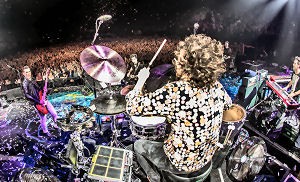 Another project is ‘Ninjas and Wolves’, your label?
Another project is ‘Ninjas and Wolves’, your label?
Yes. I’ve always felt that in the music business you’ve got to be a bit of a Ninja (you have to come through the back door and go: Here I am!), and you got to be a bit of a wolf, a bit vicious. It sort sums up how I had to deal with my career so it seemed like the appropriate title. We released our first record this January: Drewford Alabama.
Tell me more about that project.
On my way over to America for the Noisettes tour in 2007 the airline lost all my luggage, so I went to a charity shop to buy some stuff. I bought a jacket and a suitcase. Back at the hotel I found a beaten up book in the linen of the suitcase. I started flicking through the pages I found sketches, some stories, lyrics and some chord progressions – written on the side of the book is ‘Drewford Alabama’.
I didn’t do anything with the book until 2011 when I rediscovered it in my house. At that time I was in between bands and thought about what to do with my life. I was sitting in my studio with all my instruments, looking at the book and just decided to it into songs. I invited some friends round – for the first single ‘Water’ that was Fyfe Dangerfield – I showed him the book, played him some music I had been recording, we picked a page out of the book and three hours later a song appeared.
I repeated that process with twelve different artists and 2014 the album was finished.
Having such a great story behind the story I wanted to find out more about Drewford Alabama. I ended up tracking down that lady called Marianne Alabama in New York State and she told me Drewford was born in 1932, died in 1965, worked in public services in NY state and a lot of his stories were things he actually experienced at work. He never played his songs life though. What a story!! [laughs]
So I brought the album out on my label, it had incredible radio play and of the back of that I actually managed to sign it to a Japanese label too. But the best thing about it is the fact that I now have this platform to collaborate with people for the rest of my life and I have the book to use as inspiration.
So I see these side projects are very important to you?
I think it’s very important to keep pushing yourself. If you feed yourself art, it’s gonna come out in a great way – or not – but if you don’t try, you’re gonna use everything that’s inside you and then that’s it. It’s the classical problem: a band makes a great first album because it’s their whole life, all their experiences. The second album is usually whack because everything they experienced then is a tour bus, the back of a venue and all that. The second albums that are great are usually the ones where they had written more songs for the first album and some of them are still left over. [laughs] Or the second album is great because the band took some time away. It’s no rocket science: live a life! It’s as important for songs as it is for your drumming.
All my projects are art, It all has a knock on effect with the Stereophonics. It makes me a happy individual, which makes me a great drummer. You got to be happy inside, otherwise you won’t strive for perfection because you’re gonna be dealing with the thing that’s making you unhappy. Fortunately I get to deal with all the things that I love every day. I wake up really early in the morning and I spend my whole day doing Stereophonics, doing Drewford Alabama, Ninjas & Wolves, practising drums, practising guitar and piano, Poncho club and doing a bit of gardening. That’s what I do and it makes me a well rounded human being. It’s taken me a long time to understand this way of life, I’ve worked incredibly hard to get there and I’ve had lows and highs, which is a real important thing to understand in the music business. The lows are the defining moments in your career – how you conduct yourself and how you deal with getting to the next run on the ladder. That’s where we loose a lot of the people. But it’s all there, it’s all within our own power to get up in the morning, pick up your sticks and do it. Dealing with the highs and lows is an interview in itself.
And a very interesting one that would be! Thank you very much for your time Jamie!
Interview by Tobias Miorin
July 2015
Photos Hans-Peter van Velthoven

